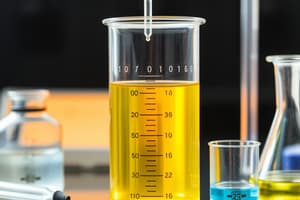Podcast
Questions and Answers
The ______ of unknown concentration reacts with a chemical of an unknown amount.
The ______ of unknown concentration reacts with a chemical of an unknown amount.
reagent
The volume and ______ of reagent used in titration indicate the amount of reagent and solution.
The volume and ______ of reagent used in titration indicate the amount of reagent and solution.
concentration
Normality is defined as the number of solute gram-equivalents divided by the volume of solution in ______.
Normality is defined as the number of solute gram-equivalents divided by the volume of solution in ______.
liters
An indicator changes color to show the achievement of the ______ in a titration.
An indicator changes color to show the achievement of the ______ in a titration.
During titration, small quantities of ______ are added to the analyte and indicator.
During titration, small quantities of ______ are added to the analyte and indicator.
The solution to be analyzed should have an accurate weight of +/- ______ g.
The solution to be analyzed should have an accurate weight of +/- ______ g.
A standard solution has a known ______.
A standard solution has a known ______.
The titration process continues until the reaction is ______ and the amount of reactant added is exact.
The titration process continues until the reaction is ______ and the amount of reactant added is exact.
Volumetric analysis is also called ______ analysis.
Volumetric analysis is also called ______ analysis.
Titration is a category of ______ analysis.
Titration is a category of ______ analysis.
Volumetric methods involve the measurement of ______ in solutions.
Volumetric methods involve the measurement of ______ in solutions.
Jean-Baptiste André ______ devised a method for determining the proportion of nitrogen in organic compounds.
Jean-Baptiste André ______ devised a method for determining the proportion of nitrogen in organic compounds.
The nitrogen accumulates in a graduated ______ during the volumetric analysis.
The nitrogen accumulates in a graduated ______ during the volumetric analysis.
The mass of the nitrogen can be calculated from the ______ it occupies under known conditions.
The mass of the nitrogen can be calculated from the ______ it occupies under known conditions.
The solution to be analyzed contains an unknown amount of ______.
The solution to be analyzed contains an unknown amount of ______.
Volumetric analysis is a widely used ______ analytical method.
Volumetric analysis is a widely used ______ analytical method.
Methyl orange is a weak ______
Methyl orange is a weak ______
In its unionized form, methyl orange is ______ in color.
In its unionized form, methyl orange is ______ in color.
Redox titration involves a reaction between the titrant and the ______.
Redox titration involves a reaction between the titrant and the ______.
Redox reactions include both ______ and reduction.
Redox reactions include both ______ and reduction.
A substance undergoes oxidation when there is an addition of ______.
A substance undergoes oxidation when there is an addition of ______.
The endpoint of the iodine redox titration is detected using a ______ indicator.
The endpoint of the iodine redox titration is detected using a ______ indicator.
During the titration, diatomic iodine is reduced to ______ ions.
During the titration, diatomic iodine is reduced to ______ ions.
Redox titrations are commonly referred to as ______ titrations.
Redox titrations are commonly referred to as ______ titrations.
The apparatus used for Volumetric Analysis includes a burette, pipette, measuring flasks, and measuring ______.
The apparatus used for Volumetric Analysis includes a burette, pipette, measuring flasks, and measuring ______.
Acid–base indicators change color at a particular ______.
Acid–base indicators change color at a particular ______.
Phenolphthalein is a weak acid and remains in the ______ form in an acidic medium.
Phenolphthalein is a weak acid and remains in the ______ form in an acidic medium.
For a weak acid vs strong alkali titration, phenolphthalein is the most ______ indicator.
For a weak acid vs strong alkali titration, phenolphthalein is the most ______ indicator.
During titration, the last drop of added alkali brings the pH of the solution to the range where phenolphthalein shows a sharp ______ change.
During titration, the last drop of added alkali brings the pH of the solution to the range where phenolphthalein shows a sharp ______ change.
In titration of strong acid versus strong base, any of the indicators can be ______.
In titration of strong acid versus strong base, any of the indicators can be ______.
For titration between a weak acid and a weak base, no ______ is available.
For titration between a weak acid and a weak base, no ______ is available.
The color of the solution in the titration flask changes from colorless to ______ when alkali is added.
The color of the solution in the titration flask changes from colorless to ______ when alkali is added.
Flashcards
Volumetric Analysis
Volumetric Analysis
A quantitative method for determining the concentration of a substance by measuring the volume of a solution of known concentration required for a reaction.
Titrimetric Analysis
Titrimetric Analysis
Another name for Volumetric Analysis.
Titration
Titration
A procedure used in volumetric analysis to determine the concentration of a substance by carefully measuring the volume of one solution needed to react with another.
Analyte
Analyte
Signup and view all the flashcards
Dumas Method
Dumas Method
Signup and view all the flashcards
Known Concentration
Known Concentration
Signup and view all the flashcards
Unknown Amount
Unknown Amount
Signup and view all the flashcards
Chemical Reaction
Chemical Reaction
Signup and view all the flashcards
Standard Solution
Standard Solution
Signup and view all the flashcards
Acid-Base Indicator
Acid-Base Indicator
Signup and view all the flashcards
Phenolphthalein
Phenolphthalein
Signup and view all the flashcards
Equivalence Point
Equivalence Point
Signup and view all the flashcards
Strong Acid vs Strong Base
Strong Acid vs Strong Base
Signup and view all the flashcards
Weak Acid vs Strong Base
Weak Acid vs Strong Base
Signup and view all the flashcards
Redox Titration
Redox Titration
Signup and view all the flashcards
Reduction
Reduction
Signup and view all the flashcards
Oxidation
Oxidation
Signup and view all the flashcards
Iodometric Titration
Iodometric Titration
Signup and view all the flashcards
Methyl Orange Indicator
Methyl Orange Indicator
Signup and view all the flashcards
Titration Curve
Titration Curve
Signup and view all the flashcards
Redox Indicator
Redox Indicator
Signup and view all the flashcards
Titrant
Titrant
Signup and view all the flashcards
Endpoint
Endpoint
Signup and view all the flashcards
Indicator
Indicator
Signup and view all the flashcards
Normality
Normality
Signup and view all the flashcards
Study Notes
Volumetric Methods of Analysis
- Volumetric analysis, also called titrimetric analysis, measures solution volume to determine analyte concentration
- Involves titration, a method used to determine the concentration of a solution by measuring the volume needed to react with another
- Dumas method: used to find nitrogen proportions in organic compounds by burning a sample and measuring the nitrogen gas produced
- Basic principles: Unknown chemical solution reacts with a reagent of known concentration (titration). An indicator shows when the reaction is completed (endpoint).
- Endpoint is the point where the indicator color changes, denoting the completion of the reaction
- Important terms: Normality (gram-equivalents of solute per liter of solution); Molarity (moles of solute per liter of solution); Endpoint (when the reaction is almost complete); Indicator (material that signifies when a result is achieved, often via color change)
- Standard solution has a known concentration
Procedure for Volumetric Analysis
- Titration setup: analyte placed in a beaker/flask. Titrant in burette/pipette, with indicator added
- Accurate sample weight is important (+/- 0.0001 g)
- Proper titrant selection needed, reactants are chosen to react quickly and efficiently
- Titrant added gradually until indicator color changes (endpoint)
- Accurate molarity calculation using known volume of reagent
- Endpoint accuracy: difference between permanent and temporary indicator change is important
Acid-Base Indicators
- Acid-base indicators change color at a specific pH, useful in titrations
- Common indicator: Phenolphthalein (colorless in acid, pink in alkali)
- Suitable indicator selection crucial, depending on the reaction type (acid/strong alkali, weak acid/strong alkali)
- Methyl orange is a suitable indicator for weak base titrations
Oxidation-Reduction Indicators
- Redox reactions involve electron transfer, changing oxidation states
- Titrations monitor reaction potential, not concentration.
- Redox titration: used to determine unknown analyte concentrations based on redox reactions, following by identifying whether the elements involved are undergoing either reduction or oxidation
- Redox reactions: addition of hydrogen or removing oxygen or accepting electrons, or a decrease of oxidation state
- Oxidation points: addition of oxygen, removal of hydrogen that was previously attached to the species, accepting/loss of electrons, or increase in oxidation state.
Additional Notes
- Important apparatus for volumetric analysis: burettes, pipettes, measuring flasks, cylinders, flasks, beakers, etc
- Standard solution is necessary for determination, its concentration must be known.
- Iodometric titration is a specific type of redox titration involves reduction of iodine through a reducing agent, ending with a color change when reacting with a starch indicator
Studying That Suits You
Use AI to generate personalized quizzes and flashcards to suit your learning preferences.




